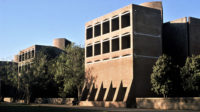'Unfortunately William Curtis' article is not knowledgeable about our design...' Read More
Read David Porter’s Defense of Holl’s Design:
"Holl’s empathy for Mackintosh’s masterly manipulation light was at the heart of his winning proposal, but it was not a singular concern, more the binder for other strands of architectural invention..." Read More
The centenary was also the moment for the Glasgow School of Art to advertise the New York–based firm Steven Holl Architects’ winning entry for the 121,094-square-foot extension. Holl’s scheme was revealed in a series of crude sketches showing stacks of studios facing north, and both studios and offices facing south toward the Renfrew Street facade of Mackintosh’s building opposite. In the vertical atrium between the studios, Holl inserted tilted tubes intended to bring daylight to the lower levels. Light rays at different angles and times of the year were indicated, suggesting that the distribution of daylight was the driving force of the scheme. Official announcements implied that this was not a project as such, but the conceptual basis for an ensuing dialogue.
So it was a surprise when in September 2010 much the same scheme (done in collaboration with JM Architects of Glasgow and Arup Engineering) was announced as the actual proposal: a cartoonlike diagram coated in skins of glass with varying degrees of translucence and transparency. Glaring problems of the initial concept were even amplified. The Holl scheme is hopelessly out of scale with Mackintosh’s building, the external volumes are clumsy, the surfaces of glass are monotonous and without relief, and there is little the human figure can relate to. For all the talk about light, the tilted tubes are likely to turn into dim wells in the winter, while the glass exteriors could reflect too much daylight onto the north studio windows of the old building in the summer. At night, when the extension is illuminated inside, its vast glass surfaces risk cancelling out the subtle Japanese-lantern effects of Mackintosh’s apertures across the street.
Mackintosh’s Renfrew Street facade, with its interaction of solids and voids, stone and glass, frame and wall, abstract volumes and tensile metal ornament, is one of the most sophisticated compositions to be found anywhere. The unrelieved areas of glass in the new building may neutralize the counterpoint of window and wall in the old one opposite. Rather than a dialogue between new and old, there is mute assertion; rather than poetic articulation, there is bland geometry; rather than tectonic clarity, there is a thin glazed skin with indecisive details. Holl has failed to grasp the urban grain of Glasgow with its hierarchy of facades from the domestic, through the commercial, to the civic. In his obsession with natural light, he has oversimplified the task and ignored the problems of cultural and institutional representation.
Where was the client during these intervening months? The unsatisfactory state of Holl’s proposal perhaps reveals what may happen when a star architect drops in from another planet and blinds a building committee with the “smoke and mirrors” of popularized phenomenology. Some good old Scottish common sense would have been in order to insist on greater rigor and a more appropriate response to the context. But then Holl is not particularly known for the subtlety of his urban interventions (e.g., that stranded whale, the Kiasma Museum in Helsinki, which clogs up a key transition in the city’s public space) or for human scale in his facades (e.g., the monotonous waffle grid of the Simmons student dormitory at MIT). Holl’s proposal for Glasgow fails to achieve the level of a convincing architectural work. It is far from being a worthy neighbor to a universally admired masterpiece.









